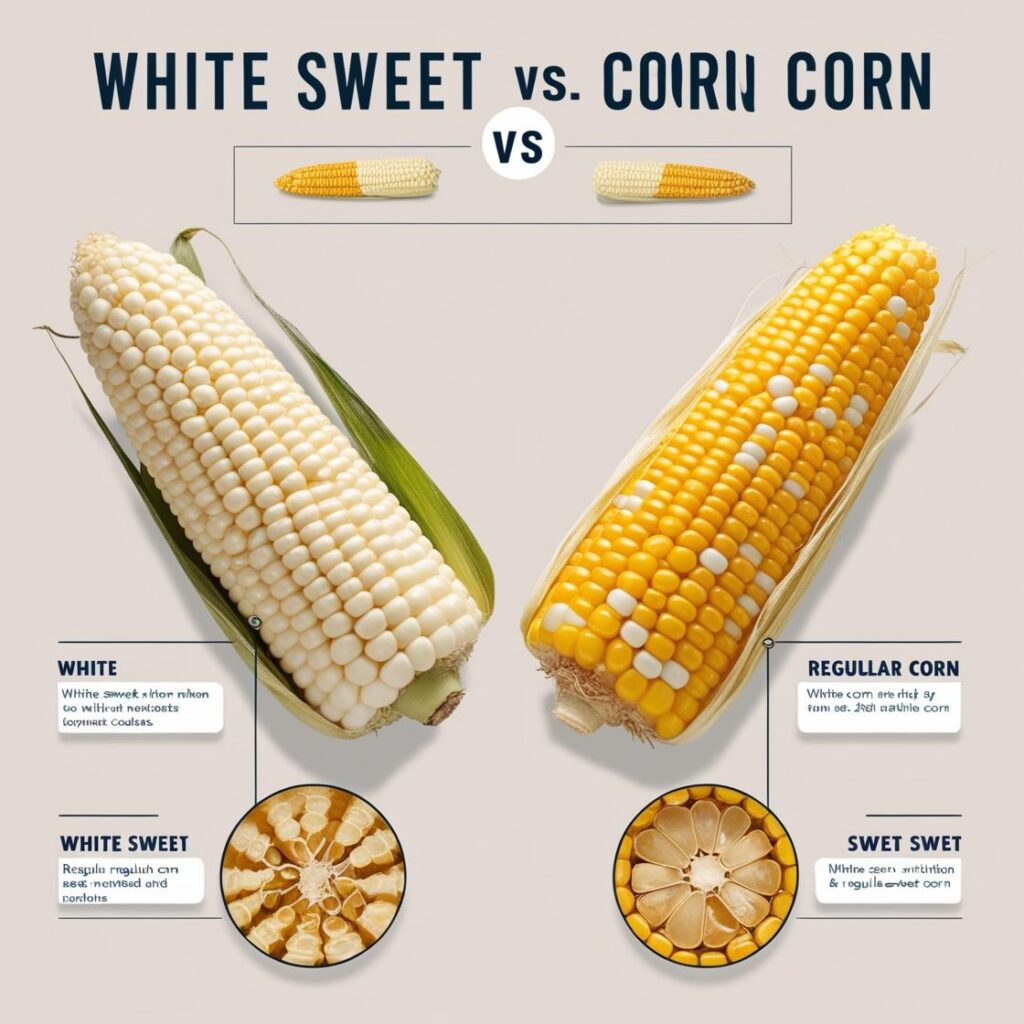White Sweet Corn vs. Regular Corn:
Which One Packs a Bigger Health Punch?
When it comes to corn, most people think of the classic yellow kernels. Not all kernels are created equal. You might have noticed two popular varieties at the market: white sweet corn and regular yellow corn. But have you ever tried white sweet corn? Grown in the lush, cool highlands of Cameron Highlands, white sweet corn is gaining popularity for its unique flavor and health benefits. But how does it stack up against regular corn? But which one is healthier? Which one offers more nutritional value? Let’s dive into the nutritional differences and benefits of each to find out which corn variety packs a bigger health punch.
What’s the Difference Between White Sweet Corn and Regular Corn?
At first glance, white sweet corn and regular yellow corn might look similar, but they have distinct differences in taste, texture, and nutritional content.
- White Sweet Corn: Known for its pale, creamy-white kernels, white sweet corn is sweeter and more tender than regular corn. It’s often enjoyed fresh, boiled, or grilled and is a staple in many Asian cuisines.
- Regular Corn (Yellow Corn): This is the classic corn variety most people are familiar with. It has a slightly firmer texture and a more robust, earthy flavor compared to white sweet corn.
But beyond taste and appearance, the real question is: Which one is healthier?
Nutritional Showdown: White Sweet Corn vs. Regular Corn
Let’s break down the nutritional profiles of both corn varieties to see which one comes out on top.
1. Calories and Carbohydrates
Both white sweet corn and regular corn are relatively similar in terms of calories and carbs. A 100-gram serving of either variety contains around 86 calories and 19 grams of carbohydrates. However, white sweet corn tends to have a slightly higher sugar content, which gives it its signature sweetness.
2. Fiber Content
Fiber is essential for digestive health, and both types of corn are good sources. However, regular yellow corn has a slight edge here, with about 2.7 grams of fiber per 100 grams, compared to 2 grams in white sweet corn. This makes yellow corn a better choice for those looking to improve digestion.
3. Vitamins and Minerals
- Vitamin A: Regular yellow corn is the clear winner here, thanks to its high beta-carotene content, which the body converts into vitamin A. This nutrient is crucial for eye health and immune function.
- Antioxidants: White sweet corn contains ferulic acid, a powerful antioxidant that helps fight inflammation and oxidative stress. While yellow corn also has antioxidants, white sweet corn’s unique compounds give it an edge in this category.
- B Vitamins: Both varieties are rich in B vitamins like folate, niacin, and thiamine, which support energy production and brain health.
4. Glycemic Index
If you’re watching your blood sugar levels, white sweet corn might be the better option. It has a lower glycemic index (GI) compared to regular corn, meaning it causes a slower, more gradual rise in blood sugar levels.
Nutritional Comparison
Both white sweet corn and regular yellow corn are packed with essential nutrients. Here’s a quick comparison of their nutritional profiles per 100 grams:
White Sweet Corn:
- Calories: 86
- Protein: 3.2 grams
- Carbohydrates: 19 grams
- Dietary Fiber: 2.7 grams
- Sugars: 6.3 grams
- Vitamin C: 6.8 mg
- Folate: 42 mcg
Regular Yellow Corn:
- Calories: 96
- Protein: 3.4 grams
- Carbohydrates: 21 grams
- Dietary Fiber: 2.8 grams
- Sugars: 6.2 grams
- Vitamin C: 7.3 mg
- Folate: 45 mcg
- Beta-Carotene: 187 mcg
Health Benefits
White Sweet Corn:
- Lower Calories: White sweet corn has slightly fewer calories, making it a better option for those looking to manage their calorie intake.
- Rich in Folate: Folate is essential for DNA synthesis and repair, and white sweet corn is a good source of this important nutrient.
- Antioxidants: Although it lacks beta-carotene, white sweet corn contains other antioxidants that help combat oxidative stress.
- Supports Heart Health: The fiber and potassium in white sweet corn can help lower cholesterol levels and regulate blood pressure.
- Boosts Immunity: With its blend of vitamins and minerals, white sweet corn can help strengthen your immune system.
- Promotes Healthy Skin: The antioxidants in white sweet corn can help reduce signs of aging and keep your skin glowing.
Regular Yellow Corn:
- Beta-Carotene Content: The yellow color in regular corn comes from beta-carotene, which the body converts into vitamin A. Vitamin A is crucial for vision, immune function, and skin health.
- Higher Carbohydrates: With slightly higher carbohydrate content, yellow corn can provide more energy, which might be beneficial for active individuals or athletes.
- Overall Nutrient Density: Yellow corn has a slightly higher nutrient density, offering more vitamins and minerals per serving.
- Improves Eye Health: The beta-carotene in yellow corn is essential for maintaining good vision and preventing age-related eye diseases.
- Aids Digestion: The higher fiber content in yellow corn makes it a great choice for promoting gut health.
- Supports Brain Function: The B vitamins in yellow corn play a key role in cognitive health and reducing the risk of neurodegenerative diseases.
Which One Should You Choose?
The answer depends on your health goals:
- Choose White Sweet Corn if you’re looking for a sweeter, lower-GI option with unique antioxidants and a tender texture.
- Choose Regular Yellow Corn if you want more fiber, vitamin A, and a slightly heartier flavor.
Ultimately, both varieties are nutritious and can be part of a healthy diet. Why not enjoy both and reap the benefits of each?
How to Incorporate Corn into Your Diet
Here are some easy ways to enjoy both white sweet corn and regular corn:
- Grilled Corn: Brush corn with a little olive oil, sprinkle with salt and pepper, and grill for a smoky, flavorful side dish.
- Corn Salad: Mix fresh corn kernels with diced vegetables, herbs, and a light vinaigrette for a refreshing salad.
- Corn Soup: Blend cooked corn with vegetable broth and spices for a creamy, comforting soup.
- Corn on the Cob: Simply boil or steam corn and enjoy it with a sprinkle of salt or a dab of butter.
Conclusion: White Sweet Corn vs. Regular Corn
So, which corn variety packs a bigger health punch? The truth is, both white sweet corn and regular corn have their unique strengths. White sweet corn shines with its antioxidants and lower glycemic index, while regular corn offers more fiber and vitamin A. The best approach is to include both in your diet for a well-rounded nutritional boost.
Ultimately, the best choice depends on your dietary needs and personal preferences. Including both varieties in your diet can provide a well-rounded mix of nutrients.
We hope this comparison helps you make an informed decision about your corn choices. If you found this post helpful, please share it with your friends and family! Let’s spread the knowledge and love for these delicious and nutritious corn varieties. 🌽❤️
If you’re in Cameron Highlands, don’t miss the chance to try our fresh, locally grown white sweet corn. It’s not just a treat for your taste buds—it’s a powerhouse of health benefits!
Share the Love!
Did you find this comparison helpful? Share this post with your friends and family to spread the word about the health benefits of white sweet corn and regular corn. And if you’ve tried both, let us know in the comments which one you prefer! 🌽
Discover more from Sweet Corn Specialist at Cameron Highlands, Malaysia
Subscribe to get the latest posts sent to your email.



